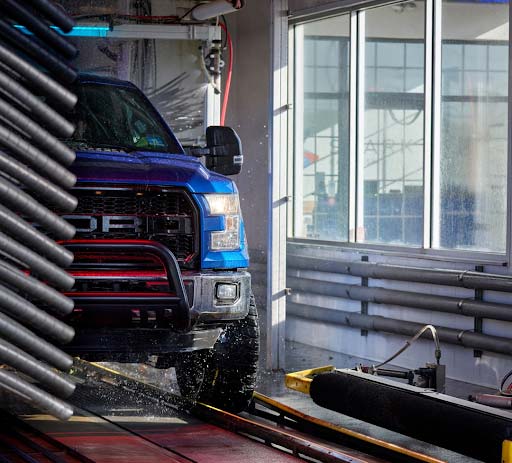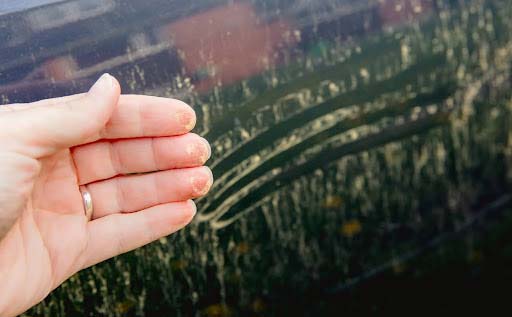Can Pollen Damage Car Paint? The Hidden Threat

The yellow plague of pollen can secretly invade your car’s exterior, getting in your paint’s nooks which can lead to scratches, fading, and corrosion over time. But don’t worry, our Cleanologists have been hard at work creating the perfect ceramic shield to help you stay protected from spring’s yellow snow.
Want the fine print on how pollen can damage your paint job? Read on below, or just save yourself the trouble and come to Spark. Our Cleanologists will be happy to shield your car from the elements.
Is Pollen Bad for Your Car Paint?
At first glance, pollen might just seem like a benign yellow powder. Yet, this seemingly innocuous substance carries a secret threat.
In reality, pollen consists of sharp, spiky microscopic grains generated by plants for reproduction. This spiky nature makes pollen far more than just a simple dusting on your car; it’s a potent substance capable of affecting your vehicle’s paintwork significantly.
When combined with water, the acidic properties of pollen can initiate corrosion on the car’s body and degrade the paint gradually. This concern brings us to an important question: Will pollen scratch car paint? The answer is, unfortunately, yes.
The accumulation of these sharp pollen particles on the vehicle’s surface can behave as an abrasive, especially if removed improperly without lubrication, such as water or a car-specific cleaner, potentially leading to scratches.
To mitigate these risks, prompt and proper removal of pollen from your vehicle is essential, ensuring it doesn’t settle into the paint’s pores or inflict surface damage. Investing in protective measures, like ceramic coatings, can provide a robust shield for your car, helping maintain the clear coat’s integrity.
Moreover, routine maintenance, including the regular replacement of the cabin air filter, plays a critical role in lessening the impact of pollen on your vehicle, thereby protecting both its interior and exterior from the adverse effects of this deceptive yellow dust.
How Long Does It Take for Pollen to Damage Car Paint?
The attack of pollen against your vehicle’s paint can start almost immediately upon contact, yet the timeline for visible damage can vary.
The moment pollen adheres to the car’s surface, it begins its corrosive dance, breaking down and releasing acids that can etch into the clear coat. This process is not just gradual wear; it’s an accelerated attack, especially when water—be it rain, dew, or mist—joins the fray, enhancing the acidic activity of pollen.
How Does Pollen Affect Your Vehicle’s Paint?
The severity of pollen’s impact on a car’s paint does not discriminate based on the type of paint. Whether your vehicle boasts a standard finish or a high-end custom paint job, the threat remains the same.
Environmental conditions, such as humidity and the frequency of rain, play a pivotal role in accelerating the damage. Pollen’s acidic compounds are merciless, and their effect is compounded by moisture, leading to etching, staining, and the breakdown of the clear coat.
The Long-Term Effects of Pollen Buildup
Over time, if pollen is allowed to settle and bond with the paint, it becomes a formidable foe. Deposits that linger for weeks become resistant to washing, stubbornly clinging to the paint and aggressively deteriorating it. This can result in unsightly stains and damage, particularly in areas where pollen accumulates most, such as the edges, valleys, and roof of the vehicle.
The most damaging aspect of pollen is its ability to infiltrate the paint’s pores, causing long-term harm that goes beyond surface level. For car owners, the solution lies in prevention and protection.
Without intervention, professional help may be necessary to restore the paint’s integrity and appearance, underscoring the importance of proactive care in combating the pervasive effects of pollen.
Having understood the factors influencing pollen’s impact on your car’s paint, it’s essential to explore more in-depth proactive measures to protect your car from pollen season.
How Do I Protect My Car Paint from Pollen?
 Protecting your car’s paint from the abrasive touch of pollen begins with a diligent cleaning regimen. Firstly, regular washing with soap, water, and microfiber towels is essential to remove pollen buildup from your car’s surface. Generous use of suds provides necessary lubrication, minimizing the risk of lasting marks on the paint.
Protecting your car’s paint from the abrasive touch of pollen begins with a diligent cleaning regimen. Firstly, regular washing with soap, water, and microfiber towels is essential to remove pollen buildup from your car’s surface. Generous use of suds provides necessary lubrication, minimizing the risk of lasting marks on the paint.
Additionally, applying a fresh coat of wax after washing provides a protective layer against pollen counts and other environmental elements. Wax sealants not only make your car easier to maintain but also shield it from the sun’s harmful UV rays, preserving its shine and value.
For enhanced protection, consider investing in ceramic coatings, which create a durable barrier against pollen buildup and other contaminants. These coatings seal the painted surfaces, making it easier to wash off pollen and maintain the car’s pristine appearance.
Lastly, don’t forget about the inside of your car. Keeping your cabin air filter fresh is crucial for blocking pollen from invading your space. Changing it every 12 months or 12,000 miles helps ensure you’re breathing clean air and keeping the interior pollen-free.
By implementing these defensive measures, car owners can effectively minimize pollen’s impact on their vehicles, ensuring long-term protection for both the exterior and interior surfaces. Furthermore, prioritizing regular visits to professional car wash services can help maintain the cleanliness and integrity of your car’s paintwork throughout pollen season and beyond.
Protect Your Car’s Paint Against Pollen Season with Spark Car Wash
As the inevitable pollen season approaches, understanding how to mitigate its impact on your vehicle becomes paramount.
Pollen, while a natural part of the environment, carries the potential to significantly affect your car’s surface, leading to buildup that can seep into the paint’s pores and cause lasting damage. Regular washing stands as a crucial defense mechanism, preserving the integrity and appearance of your car’s paint. However, finding the time to wash your car by hand can be a daunting task amidst our busy lives.
This is where the value of a reputable car wash comes into play. However, not all car washes are created equal, and some may inadvertently do more harm than good, utilizing harsh brushes and chemicals that could exacerbate the damage.
At Spark Car Wash, we understand the impact of pollen buildup and prioritize gentle, effective cleaning techniques and products designed to protect your vehicle against the most damaging aspects of pollen exposure.
From ceramic coatings that provide an additional layer of defense to specialized services that ensure every part of your vehicle is treated with care, we offer a comprehensive solution to keeping your car pristine throughout pollen season and beyond.
Don’t let pollen season diminish your car’s shine and value. Make Spark Car Wash your go-to for safeguarding your car’s paint, ensuring it remains as vibrant and protected as the day you drove it off the lot.
Visit one of our locations for a sparkling car wash near you!
All Locations
Folsom, PA
Lacey, NJ
Ledgewood, NJ
Mount Holly, NJ
Sicklerville, NJ
Woodbridge, NJ
Woodland Park, NJ
West Nyack, NY